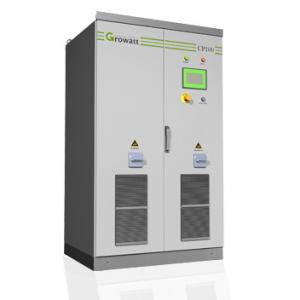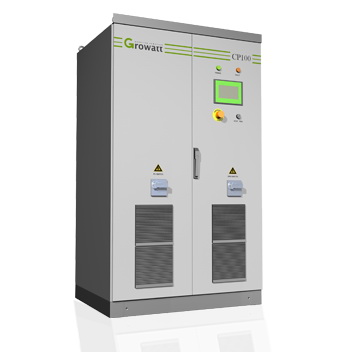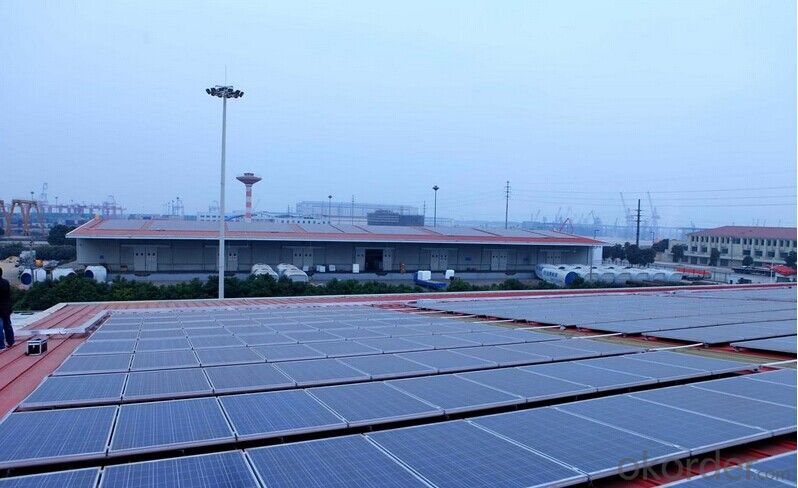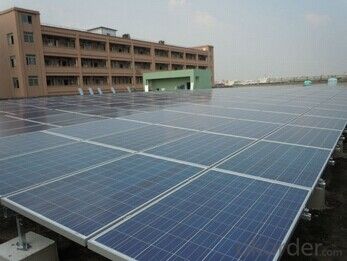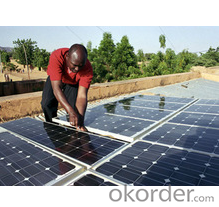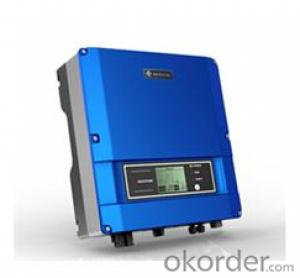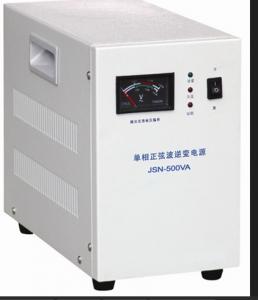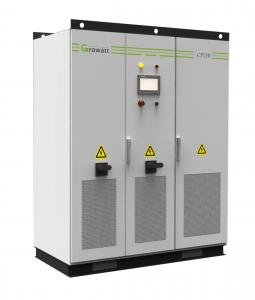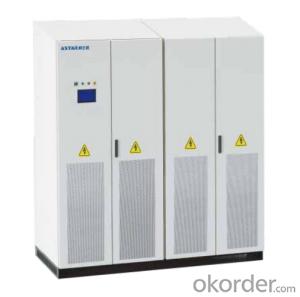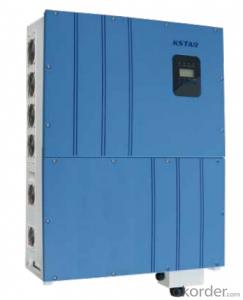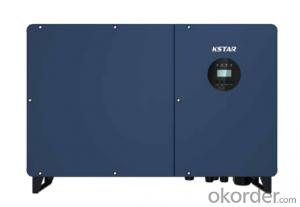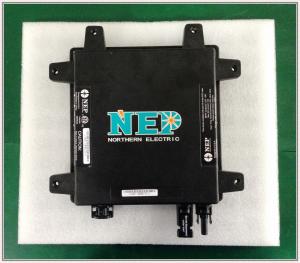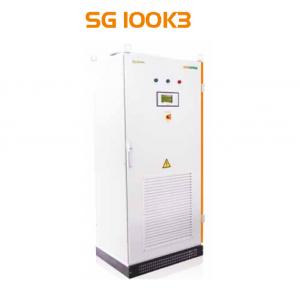PV Grid-Tied Inverter CP100, 100kw, Power Inverter
- Loading Port:
- Shekou
- Payment Terms:
- TT or LC
- Min Order Qty:
- 20 pc
- Supply Capability:
- 10000 pc/month
OKorder Service Pledge
OKorder Financial Service
You Might Also Like
PV grid-tied inverter CP100, 100kw, power inverter
Specifications
Low voltage ride through
Active power continuous adjustment (0-100%)
Reactive power adjustable, PF range 0.9lagging aa 0.9lead
Low voltage ride through
Active power continuous adjustment (0-100%)
Reactive power adjustable, PF range 0.9lagging – 0.9leading
Maximum conversion efficiency of 98.6%
Multi-language touch panel monitoring interface
Rigorous grid environment adaptable
Auxiliary electrical heating (optional)
High altitude application adaptable<6000m (power derating over 3000m)
Certificates and approvals including CE,CGC solar,BDEW etc.
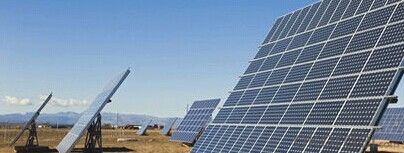
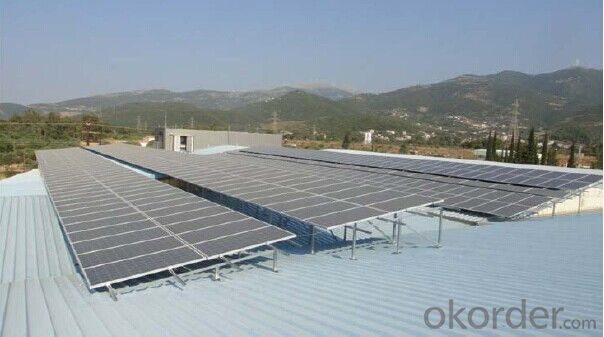
Input Data (DC)
Max. DC voltage | 1000V |
Full-load MPP-Voltage range | 450V-820V |
Nominal DC voltage | 500V |
Max. input current | 250A |
Number of MPP trackers | 1 |
Max. number of parallel strings | 2 |
Nominal AC output power | 100KVA |
Nominal AC output voltage | 400V |
AC output voltage range | 360V-440V |
Nominal AC output frequency | 50Hz/60Hz |
AC output frequency range | 45Hz-55Hz/55Hz-65Hz |
Max.output current | 160A |
PF (cosφ) | 0.9lagging – 0.9leading |
THDI | <3%(@pac,r)< span=""> |
Efficiency
Max. conversion efficiency | 97.5% |
Euro-eta | 96.5% |
MPPT efficiency | 99.9% |
Protection
DC disconnection device | yes |
AC disconnection device | yes |
DC Over-voltage protection | Arrester typeⅡ |
AC Over-voltage protection | Arrester typeⅡ |
Grid monitoring/Regulation | yes/yes |
PV Isolation detection | yes |
eneral Data
Dimension (W/H/D) | 1100/1890/850 mm |
Weight | 1000kg |
Operating temperature range | -20°C … +50°C |
Humidity | 15% - 95% |
Protection level | IP20 |
Noise emission | 65dB(A)@1m |
Altitude | 3000m |
Standby power consumption | <100w< p=""> |
Cooling concept | Forced Air Cooling |
Topology | Industrial Frequency Transformer |
Display | LCD Touch Panel |
Communication interface | RS 485/ Ethernet |
Certificate & Approval
Approval | CE/CQC/TUV/BDEW |
FAQ
1. Have any design tool and how to use it?
Shine Design is the system design software just for inverters, It can conduct installers to figure out panel numbers for a system, panel numbers for each string, and which inverter model is suitable for the system. Moreover, it can print a design report after input all necessary parameters, can calculate DC/AC wire wastage, annual generation, etc.
2. Does the inverter have monitoring solutions for residential system?
For small rating system, we have wired two monitoring solution (ShineNet via RS232 or RS485). (a) Local wireless monitoring solution (ShineVision via RF module communication) (b) Global wireless monitoring solution (WIFI module via WIFI network)
3. Do you have free solution for monitoring?
ShineNet is an inverter monitoring software run in Windows XP, Windows Vista, Windows 7 operating system. It can monitor inverter via RS232 (or RS232 convert to USB cable) and RS485 wire connection. Customers can purchase the cable locally to get the inverter monitored, it is simple.
- Q: Can a solar inverter be used with a solar-powered air purification system?
- Yes, a solar inverter can be used with a solar-powered air purification system. A solar inverter is responsible for converting the direct current (DC) generated by a solar panel into usable alternating current (AC) that can power electrical appliances. In the case of a solar-powered air purification system, the solar inverter can convert the DC electricity produced by the solar panels into AC power needed to operate the air purification system, allowing it to function efficiently with solar energy.
- Q: What is the efficiency of a solar inverter?
- The efficiency of a solar inverter refers to how effectively it converts the direct current (DC) power generated by solar panels into alternating current (AC) power that can be used to power household appliances or be fed back into the grid. It is typically measured as a percentage and represents the amount of DC power that is successfully converted into usable AC power. A higher efficiency indicates a more effective conversion process, resulting in less energy loss and maximizing the overall output of the solar system.
- Q: How does a solar inverter handle power factor correction?
- A solar inverter handles power factor correction by continuously monitoring the power factor of the electrical load and adjusting its operation accordingly. It applies various control techniques to ensure that the power factor is maintained close to unity, ultimately improving the efficiency and stability of the solar power system.
- Q: What is the role of a solar inverter in reactive power compensation?
- To regulate and control the flow of reactive power in a solar power system, a solar inverter plays a crucial role in reactive power compensation. The presence of inductive or capacitive elements in the system causes reactive power to oscillate between the source and load. Although this power does not contribute to the actual work done by the system, it is necessary for the operation of specific devices. A solar inverter, specifically designed for reactive power compensation, is capable of measuring the reactive power in the system and adjusting its operation accordingly. It has the ability to generate or absorb reactive power as needed to maintain a power factor close to unity. The power factor is a measure of the efficiency of electrical energy utilization, and a high power factor indicates efficient electricity usage. By compensating for reactive power, a solar inverter ensures that the solar power system operates at optimal efficiency. It alleviates the burden on the grid by locally supplying or absorbing reactive power instead of relying on the grid for compensation. This not only improves the overall quality of power but also reduces system losses. Furthermore, it helps stabilize voltage levels and minimize voltage fluctuations, which can be advantageous for delicate electrical equipment. In conclusion, the role of a solar inverter in reactive power compensation is vital for regulating the flow of reactive power in a solar power system, maintaining a high power factor, and improving overall system efficiency. It plays a pivotal role in ensuring the optimal operation of the solar power system and diminishing the dependence on the grid for reactive power compensation.
- Q: How does a solar inverter handle low light conditions?
- A solar inverter handles low light conditions by continuously monitoring the amount of sunlight received by the solar panels. When light levels drop, the inverter adjusts its operation to maximize power output by optimizing the voltage and current levels. It uses advanced algorithms and power electronics to convert the available sunlight into usable electricity efficiently, ensuring that even in low light conditions, the solar system continues to generate power.
- Q: Can a solar inverter be used with solar-powered security systems?
- Yes, a solar inverter can be used with solar-powered security systems. Solar inverters are essential components in solar power systems as they convert the direct current (DC) generated by solar panels into alternating current (AC) that can be used to power various devices, including security systems. By using a solar inverter, solar-powered security systems can efficiently utilize the energy generated by the sun to operate and provide round-the-clock security.
- Q: How is the output voltage and frequency of a solar inverter regulated?
- The output voltage and frequency of a solar inverter are regulated through advanced control algorithms and feedback mechanisms. These control algorithms continuously monitor the input power generated by the solar panels and adjust the inverter's output voltage and frequency accordingly. The regulation process involves various components such as voltage regulators, frequency detectors, and digital signal processors that ensure the output voltage and frequency are in sync with the grid or the desired specifications. Additionally, some inverters may also have built-in mechanisms to protect against voltage and frequency fluctuations, ensuring a stable and reliable power supply to connected devices or the grid.
- Q: What is the maximum number of solar panels that can be connected to a single inverter?
- The maximum number of solar panels that can be connected to a single inverter depends on the inverter's capacity and the specifications provided by the manufacturer. It can vary widely based on factors such as the wattage rating of the inverter, the voltage and current output of the solar panels, and the electrical compatibility between them. It is important to consult the manufacturer's guidelines or seek professional advice to determine the appropriate number of panels for a specific inverter.
- Q: How does a solar inverter handle electromagnetic interference?
- A solar inverter handles electromagnetic interference by utilizing filters and shielding techniques to minimize the impact of external electromagnetic disturbances. These measures help ensure that the inverter operates efficiently and reliably, without any significant disruption caused by electromagnetic interference.
- Q: How does a solar inverter handle voltage dip and interruption?
- A solar inverter handles voltage dip and interruption by continuously monitoring the incoming grid voltage. In case of a voltage dip, it utilizes its internal control mechanisms to stabilize and regulate the output voltage, ensuring a consistent power supply to the connected solar panels. In the event of a complete interruption of grid power, the inverter quickly switches to an off-grid mode, where it utilizes the solar energy stored in batteries (if available) to continue powering the connected loads. This way, it effectively mitigates the impact of voltage fluctuations and interruptions, ensuring uninterrupted power supply from the solar panels.
Send your message to us
PV Grid-Tied Inverter CP100, 100kw, Power Inverter
- Loading Port:
- Shekou
- Payment Terms:
- TT or LC
- Min Order Qty:
- 20 pc
- Supply Capability:
- 10000 pc/month
OKorder Service Pledge
OKorder Financial Service
Similar products
Hot products
Hot Searches
Related keywords
